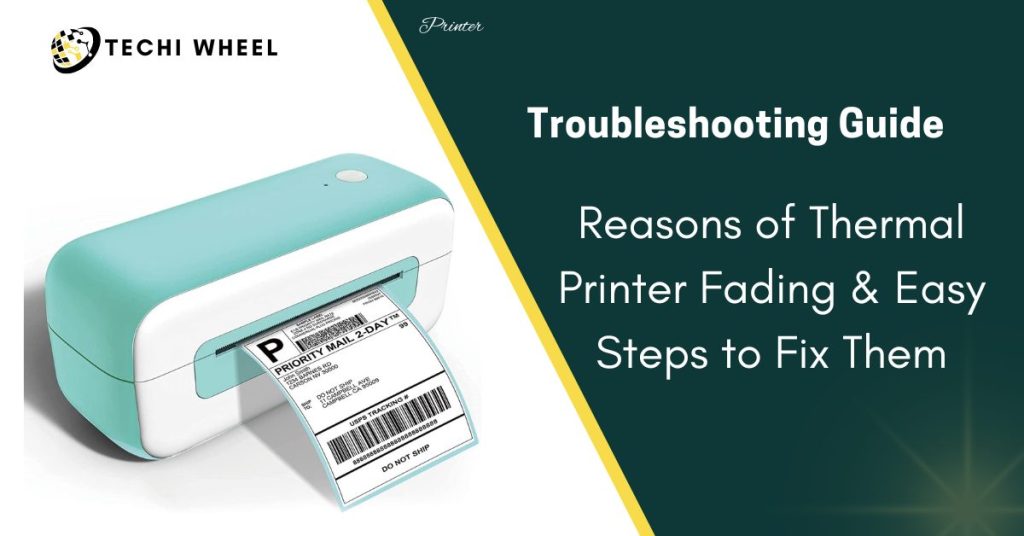Thermal printers are popular in many industries, such as retail, healthcare, and logistics. However, users may encounter fading problems when printing. This can be frustrating and can even make it difficult for important information to be read. In this article, discover How to prevent and fix fading on your thermal printer.
Take preventative measures to prevent fading and apply effective solutions to fix it.

Does Thermal Print Fade?
Yes, thermal prints can fade over time. Thermal printing uses heat-sensitive paper, and exposure to light, heat, or friction can cause the print to gradually fade or disappear. To extend the lifespan of thermal prints, it’s important to store them in a cool, dry place, away from direct sunlight and heat sources.
Why Does Thermal Print Fade?
Reasons for why is my thermal printer ink faded
The causes of thermal printer fading should be understood before we discuss solutions. The following are some of the most common causes of thermal printer fading:
Worn-out print head
Print heads are the components of thermal printers that produce prints. Wear and tear on the print head can result in lighter or faded prints over time.
Dirty print head
Dust, dirt, and other debris can accumulate on the print head, causing it to produce faded prints.
Low-quality thermal paper
Not all thermal paper is created equal. Low-quality thermal paper can fade more easily than high-quality paper.
Exposure to heat or sunlight
Thermal prints can fade when exposed to heat or sunlight, especially if they are not printed on high-quality thermal paper.
Overuse of cleaning solutions
While it’s critical to clean the print head regularly, overuse of cleaning solutions can damage the print head and cause it to produce faded prints.
Also Read:How to Make a Copy on a Canon Printer

How to Fix Thermal Printer Fading?
Solutions for Thermal Printer Fading
Now that we’ve explored some of the reasons for thermal printer fading, let’s dive into the solutions for fixing it.
Replace the print head
A worn-out print head may be the most effective solution for thermal printer fading. It is recommended that you consult your printer’s manual or contact the manufacturer if you need to replace the print head. The fading should be resolved once the new print head has been installed.
Clean the print head
The fading issue may be fixed by cleaning the print head. Identify the best method of cleaning your printer’s print head by consulting your manual or contacting the manufacturer. There are printers that self-clean, as well as those that require manual cleaning with a cleaning pen or cleaning solution.
Use high-quality thermal paper
It is possible to prevent fading by using high-quality thermal paper. Thermal printing paper should have a higher sensitivity to heat and be specially designed for thermal printing. You will get a sharper, more durable, and fade-resistant print this way.
Store prints carefully
Heat or sunlight can cause your prints to fade, so store them carefully to prevent this. You should keep them in a cool, dry place and avoid exposing them to direct sunlight or high temperatures.
Use cleaning solutions sparingly
Despite the importance of cleaning the print head regularly, overuse of cleaning solutions can actually cause fading. To avoid damaging the print head, use cleaning solutions sparingly and follow the instructions carefully.
Adjust print density
It may help to adjust the print density if the fading is only affecting certain parts of the print. Depending on your printer, you may need to adjust the print density by consulting the manual or contacting the manufacturer. In order to produce a sharper, more readable print, the print density should be increased.
Use a protective coating
Thermal prints can be protected from fading by applying a protective coating. UV-resistant and water-resistant coatings are among the types of protective coatings available. For guidance on the best protective coating for your printer, consult the manual or contact the manufacturer.
Conclusion
Despite the frustration associated with thermal printer fading, it is important to understand that the problem can be solved. Use a protective coating, replace the print head, clean the print head, store prints carefully, use cleaning solutions sparingly, adjust print density, and use high-quality thermal paper.
FAQs
Why is my thermal label printer ink faded?
Your thermal label printer ink may fade due to heat exposure, poor quality labels, or incorrect storage. Make sure to store labels in a cool, dry place and adjust printer settings.
How to keep thermal paper from fading?
Store thermal paper in a cool, dry place away from heat and sunlight. Use high-quality labels and adjust printer settings for optimal print quality.
What is the lifespan of a thermal printer?
The lifespan of a thermal printer typically ranges from 3 to 5 years, depending on usage and maintenance. Regular cleaning and proper storage can extend its life.
Does thermal printing fade over time?
Label material is sensitive to heat, causing it to fade, resulting in the label becoming difficult to read and scan as time passes. Furthermore, direct thermal labels are vulnerable to scratches and contact with water, chemicals, and intense sunlight.
How do you restore faded thermal paper?
Warm the paper with a heating tool (such as a hair dryer or electric heating pad). The whole thermal paper will alter its color. The hue of the initially printed section will be somewhat lighter, and the text will become visible.


